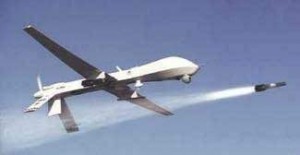On Thursday, President Obama admitted that two al Qaeda hostages, an American and an Italian, were killed in a US drone strike in Pakistan in January. He also said that two other US citizens had been killed in a strike later that month.
The reaction in Congress to the news was predictable, especially among the presidential hopefuls in the Senate. Rand Paul called the deaths “a tragedy,” but refused to address the attacks in general. Ted Cruz called for an investigation (as did Obama), but placed the blame at the feet of al-Qaeda.
But, the most telling (and chilling) response came from Lindsey Graham. The South Carolina Senator said; “Collateral damage is part of war. I’ve got no problem at all with anything that happened other than my deepest sympathies for those that were killed after being held hostage by al-Qaeda… they can look and see what went wrong, but I am not for stopping this program.”
Along with the admission came an apology to the hostages’ families. We wonder why the President stopped there, because if we’re apologizing for innocent people being killed by our drones in Pakistan, those two are just a drop in the bucket.
Since 2004, more than 2,400 people have been killed by CIA drone strikes in the tribal areas of north west Pakistan, according to Naming The Dead, a project of The Bureau of Investigative Journalism. Of those only 721 have been identified, and of the 721, only 303 are alleged to be militants. Only 4% of the total number killed have been identified as members of al-Qaeda, who are what our government uses for justification for the drone strikes.
Who are the other alleged militants? Mostly members of either the Pakistani Taliban or groups that align with the Taliban. And who do you suppose has been fighting the Taliban since 2004? If you guessed the Pakistani Army, you win the prize. We think we’re beginning to see a pattern.
However, this still leaves over half of the identified victims as innocent civilians. Over 60% of drone strikes in Pakistan are on domestic buildings; a practice that’s been banned in Afghanistan since 2008. We wonder when the apology to their families is coming, as long as it appears that we’re beginning to somewhat embrace accountability. Or, are they, as Lindsey Graham says, merely “collateral damage”?
Is it any surprise that according to recent reports, the US drone policy has become the top recruiting tool for al-Qaeda in recent months?
So, why does the government persist with the drone program? It’s easier to sell to Congress and the public. “We aren’t officially at war- in fact, we don’t have boots on the ground. We send in the drones instead of troops.” In other words, they can wage war by remote control in countries too far away to retaliate, and if there’s no troop involvement, all’s good.
It’s not only Congress who likes drones. Last week, Navy Secretary Ray Mabus said that the F-35 will probably be the last manned aircraft that the Navy and Marines will ever buy, and drones are becoming more and more the norm. Frankly, this scares us.
Will the use of drones stop? Not unless we make ourselves heard. Our drone program when and if it’s successful is no more than a state sanctioned assassination program. When it’s not successful, innocent lives are taken. Either way, it’s murder plain and simple.
Editorial Note: The Bureau of Investigative Journalism relies on donations in order to do the work they are impassioned with. We strongly recommend considering supporting them.


